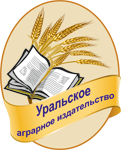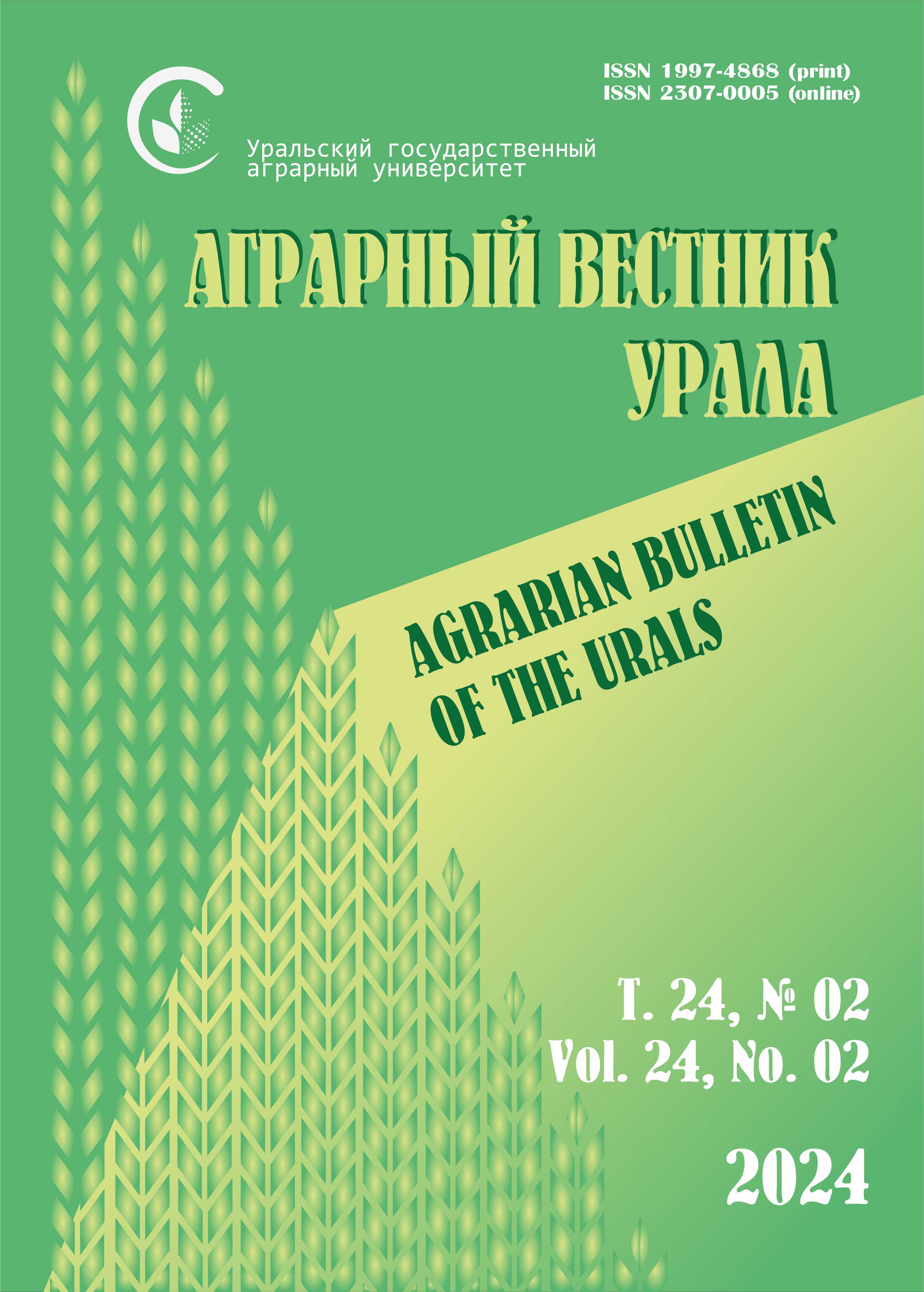Orenburg, Orenburg, Russian Federation
Russian Federation
Abstract. The article provides data on the reserves of productive moisture, the content of nitrate nitrogen, and the yield of spring wheat varieties when grown under different backgrounds of basic tillage. The purpose of the research is to study the response of spring soft and durum wheat varieties to the methods of basic tillage. Methods. The object of research is 3 varieties of spring soft wheat and 2 varieties of spring durum wheat. The experiments were carried out in the central zone of the Orenburg region. For 5 years, two options for basic soil cultivation were studied: plowing to a depth of 23–25 cm and moldless loosening to a depth of 25–27 cm. Scientific novelty. The reaction of spring wheat varieties to the methods of basic tillage, taking into account the reserves of productive moisture and the content of nitrate nitrogen in the soil, in the arid conditions of the Orenburg Cis-Urals was revealed. Results. The reserves of productive moisture during the sprouting phase of spring wheat in a meter layer of soil were satisfactory (less than 130 mm) for four years out of five years of research, and good for one year (150-153 mm). The advantage of non-moldboard tillage was noted in all years of research with the exception of 2019, when the mouldboard background contained 18 mm more soil moisture. Depending on weather conditions, the amount of nitrate nitrogen in the soil varied from very low values in 2022 to high and very high values in 2017 and 2019–2020. The yield of spring wheat, on average according to experience, was 0.6 c per 1 ha higher against the background of moldless loosening. The varietal response to basic soil tillage methods has been established. The Uchitel’ variety did not respond to processing techniques. For other varieties, the difference in favor of non-moldboard tillage ranged from 0.4 centners per 1 hectare for the Tulaykovskaya zolotistaya variety, to 0.7–0.8 centners per 1 hectare for the varieties Ul’yanovskaya 105, Orenburgskaya 10, Bezenchukskaya 210.
tillage methods, spring wheat, variety, plowing, moldboard loosening, productivity, productive moisture, nitrate nitrogen
1. Pakul' A. L., Lapshinov N. A., Pakul' V. N., Bozhanova G. V. Zasorennost' posevov yarovoy myagkoy pshenicy v zavisimosti ot sistemy obrabotki pochvy // Sibirskiy vestnik sel'skohozyaystvennoy nauki. 2020. T. 50. № 3. S. 16-27. DOI:https://doi.org/10.26898/0370-8799-2020-3-2. EDN: https://elibrary.ru/UCCPNK
2. Lagunov R. V. Vliyanie osnovnoy obrabotki pochvy na zasorennost' i urozhaynost' yarovoy pshenicy v severnoy lesostepi Tyumenskoy oblasti // Aktual'nye voprosy nauki i hozyaystva: novye vyzovy i resheniya: sbornik materialov LV Studencheskoy nauchno-prakticheskoy konferencii. Tyumen', 2021. S. 556-560. EDN: https://elibrary.ru/TGNSXY
3. Miller S. S., Antropov V. A. Vozdelyvaniya yarovoy pshenicy po osnovnoy obrabotke pochvy v Zapadnoy Sibiri // Vestnik Michurinskogo gosudarstvennogo agrarnogo universiteta. 2021. № 4 (67). S. 47-50. EDN: https://elibrary.ru/EQXFJG
4. Janusauskaite D., Kadziene G. Influence of Different Intensities of Tillage on Physiological Characteristics and Productivity of Crop-Rotation Plants // Plants. 2022. Vol. 11 (22). Article number 3107. DOI:https://doi.org/10.3390/plants11223107. EDN: https://elibrary.ru/TMXLTA
5. Kuzina E. V., Nemcev S. N. Itogi izucheniya razlichnyh sistem obrabotki pochvy v zernoparovom sevooborote na chernozemah Srednego Povolzh'ya // Sel'skohozyaystvennyy zhurnal. 2019. T. 12. № 5. S. 65-71. DOI:https://doi.org/10.25930/0372-3054/010.5.12.2019. EDN: https://elibrary.ru/PWBTUX
6. Novohizhnyy N. V., Kovalenko A. M., Kovalenko A. A. Vliyanie obrabotki pochvy na ee agrofizicheskie svoystva i produktivnost' rannih yarovyh kul'tur v yuzhnoy stepi Ukrainy // Aktual'nye voprosy sovershenstvovaniya sistem zemledeliya v sovremennyh usloviyah: materialy Vserossiyskoy nauchno-prakticheskoy konferencii (s mezhdunarodnym uchastiem). Mahachkala, 2020. S. 110-114. EDN: https://elibrary.ru/PDWIDY
7. Shahova O. A. Izmenenie agrofizicheskih svoystv seroy lesnoy pochvy pri razlichnyh vidah zyablevoy obrabotki v usloviyah severnoy lesostepi Tyumenskoy oblasti // Vestnik Michurinskogo gosudarstvennogo agrarnogo universiteta. 2021. № 3 (66). S. 33-37. EDN: https://elibrary.ru/TZODLE
8. Lentochkin A., Shirobokov P., Atnabaeva N. A. Nulevaya, minimal'naya ili otval'naya obrabotka pochvy v landshaftnom zemledelii Srednego Predural'ya // Novye metody i rezul'taty issledovaniy landshaftov v Evrope, Central'noy Azii i Sibiri: monografiya. V 5 tomah. T. 4. Moskva, 2018. S. 115-120. DOI: https://doi.org/10.25680/1205.2018.82.63.288; EDN: https://elibrary.ru/YTTLVR
9. Jakab G., Madarász B., Masoudi M., Karlik M., Király C., Zacháry D., Filep T., Dekemati I., Centeri C., Al-Graiti T., Szalai Z. Soil organic matter gain by reduced tillage intensity: Storage, pools, and chemical composition // Soil and Tillage Research. 2022. Vol. 226. Article number 105584. DOI:https://doi.org/10.1016/j.still.2022.105584. EDN: https://elibrary.ru/JFTGQA
10. Semenihina Yu. A., Kambulov S. I. Vliyanie sposobov osnovnoy obrabotki pochvy na vlagotemperaturnyy rezhim pochvy i urozhaynost' ozimoy pshenicy // Melioraciya i gidrotehnika. 2021. T. 11. № 3. S. 182-193. DOI:https://doi.org/10.31774/2712-9357-2021-11-3-182-193. EDN: https://elibrary.ru/OREOQU
11. Aver'yanova I. P., Morkovkin G. G. Vliyanie razlichnyh priemov osnovnoy obrabotki pochvy na pitatel'nyy rezhim pochvy i urozhaynost' zerna yarovoy pshenicy // Perspektivy vnedreniya innovacionnyh agrotehnologiy pri vozdelyvanii sel'skohozyaystvennyh kul'tur: Rossiyskaya nauchno-prakticheskaya konferenciya, posvyaschennaya 75-letnemu yubileyu agronomicheskogo fakul'teta Altayskogo GAU. Barnaul, 2018. S. 5-9. EDN: https://elibrary.ru/TTUSAQ
12. Kutilkin V. G., Zudilin S. N. Effektivnost' minimalizacii osnovnoy obrabotki pochvy i udobreniy pod yachmen' // Teoriya i praktika sovremennoy agrarnoy nauki: materialy III nacional'noy (vserossiyskoy) nauchnoy konferencii s mezhdunarodnym uchastiem. Novosibirsk, 2020. T. 1. S. 151-155. EDN: https://elibrary.ru/TMNVKB
13. Levkina A. Yu., Kudashova A. O. Vliyanie deficita vlagi i sposobov osnovnoy obrabotki pochvy na urozhaynost' ozimoy pshenicy v Saratovskom Zavolzh'e // Innovacii prirodoobustroystva i zaschity okruzhayuschey sredy: materialy I Nacional'noy nauchno-prakticheskoy konferencii s mezhdunarodnym uchastiem. Saratov, 2019. S. 535-539. EDN: https://elibrary.ru/VWZSPB
14. Markovskaya G. K., Chugunova O. A. Vliyanie sposoba osnovnoy obrabotki na mikrobiotu pochvy i urozhaynost' yachmenya v usloviyah Srednego Povolzh'ya // Izvestiya Samarskoy gosudarstvennoy sel'skohozyaystvennoy. 2019. T. 4. № 2. S. 3-8. DOI:https://doi.org/10.12737/article_5cdbc442e01672.39268090.
15. Saurabh K., Rao K. K., Mishra J. S., Kumar R., Poonia S. P., Samal S. K., Roy H. S., Dubey A. K., Choubey A. K., Mondal S., Bhatt B. P., Verma M., Malik R. K. Influence of tillage based crop establishment and residue management practices on soil quality indices and yield sustainability in rice-wheat cropping system of Eastern Indo-Gangetic Plains // Soil & Tillage Research. 2021. Vol. 206. Article number 104841. DOI:https://doi.org/10.1016/j.still.2020.104841.
16. Ding J., Li F., Le T. et al. Tillage and seeding strategies for wheat optimizing production in harvested rice fields with high soil moisture // Scientific Reports. 2021. Vol. 11. Article number 119. DOI:https://doi.org/10.1038/S41598-020-80256-7. EDN: https://elibrary.ru/HQRVEG
17. Pardo G. et al. Effects of reduced and conventional tillage on weed communities: results of a long-term experimental in Southwestern Spain // Planta Daninha. 2019. Vol. 37. DOI:https://doi.org/10.1590/S0100-83582019370100152.
18. Gandía M. L., Del Monte J. P., Tenorio J. L., Santín-Montanyá M. I. The influence of rainfall and tillage on wheat yield parameters and weed population in monoculture versus rotation systems // Scientific Reports. 2021. Vol. 11. No. 1. Article number 22138. DOI:https://doi.org/10.1038/s41598-021-00934-y. EDN: https://elibrary.ru/WWHHLM
19. Sun W., Canadell J. G., Yu L., Yu L., Zhang W., Smith P., Fischer T., Huang Y. Climate drives global soil carbon sequestration and crop yield changes under conservation agriculture // Global Change Biology. 2020. Vol. 26. No. 6. Pp. 3325-3335. DOI:https://doi.org/10.1111/gcb.15001.
20. Dospehov B. A. Metodika polevogo opyta (s osnovami statisticheskoy obrabotki rezul'tatov issledovaniy). 5-e izd. Moskva: Al'yans, 2014. 351 s.









